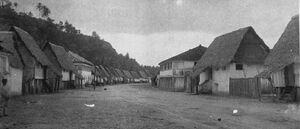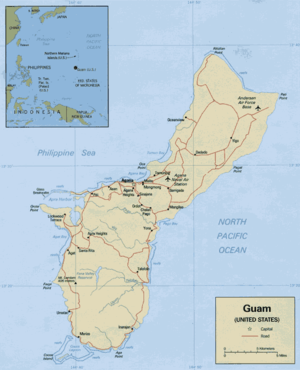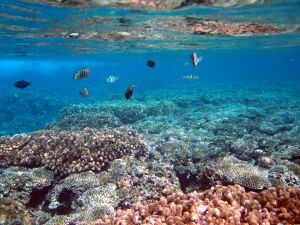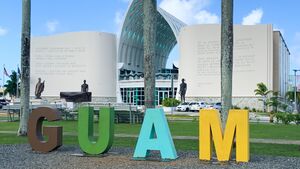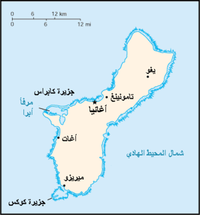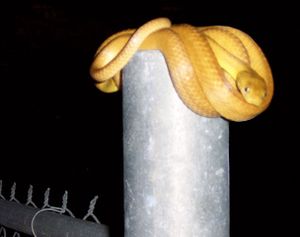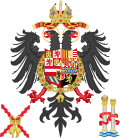جوام
Coordinates: 13°30′N 144°48′E / 13.500°N 144.800°E
| Territory of Guam Guåhån | |
|---|---|
Motto: Tano I' Man Chamorro | |
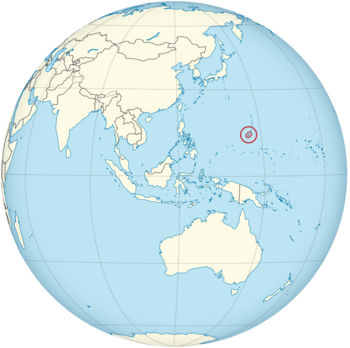 | |
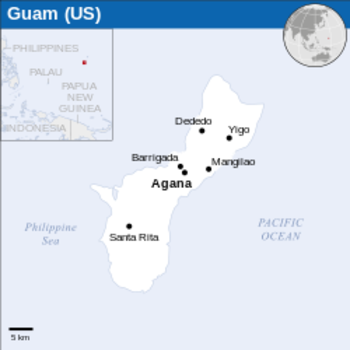 | |
| العاصمة | هگاتنيا |
| أكبر مدينة | Dededo |
| اللغات الرسمية | |
| جماعات عرقية (2015[1]) | |
| الدين (2010) | |
| صفة المواطن | Guamanian |
| Sovereign state | الولايات المتحدة |
| الحكم | Territorial رئاسي جمهورية دستورية |
• الرئيس | جو بايدن (د) |
• Governor | Lou Leon Guerrero (D) |
| Josh Tenorio (D) | |
| Legislature | المجلس التشريعي لگوام |
| Unincorporated and Organized Territory of the United States | |
• Part of جزر الهند الشرقية الاسبانية | 1565 |
| 1898 | |
| 1941 | |
• Part of امبراطورية اليابان | 1941 |
| 1944 | |
| المساحة | |
• إجمالي | 541.3 km2 (209.0 sq mi) (192nd) |
• Water (%) | negligible |
| التعداد | |
• تقدير 2021 | 168,801[1] (177th) |
• Density | 299/km2 (774.4/sq mi) |
| ن.م.إ. (PPP) | تقدير 2016 |
• الإجمالي | $5.79 billion[1] |
• للفرد | $35,600[1] |
| ن.م.إ. (اسمي) | تقدير 2019 |
• إجمالي | US$6.311 billion[2] |
• للفرد | $37,387.22 |
| HDI (2017) | ▲ 0.901 very high |
| العملة | United States dollar (US$) (USD) |
| منطقة التوقيت | (UTC+10:00) |
| صيغة التاريخ | mm/dd/yyyy |
| القيادة في الجانب | right |
| Calling code | +1-671 |
| Internet TLD | .gu |
گوام (Guam ؛ /ˈɡwɑːm/؛ تشامورو: Guåhan [ˈɡʷɑhɑn]) هي جزيرة وإقليم منظم وغير مُشهر بالولايات المتحدة، في ميكرونيزيا في غرب المحيط الهادي،[4][5] وهي النقطة والإقليم الأمريكي الأقصى إلى الغرب (كما يُنظر إليه من المركز الجغرافي للولايات المتحدة)؛ في أوقيانوسيا، هي الأكبر والأقصى جنوباً بين جزر ماريانا وأكبر جزيرة في ميكرونيزيا. عاصمة گوام هي هگاتنيا، وأكبر القرى تعداداً هي دىدىدو.
People born on Guam are American citizens but have no vote in the United States presidential elections while residing on Guam and Guam delegates to the United States House of Representatives have no vote on the floor. غالبية ساكنها هم التشامورو الذين سكنوا الجزيرة منذ نحو 3500 عام، وهم على قرابة مع الشعوب الأسترونيزية في إندونيسيا والفلبين وتايوان وميكرونيزيا وپولينيزيا. وفي 2021، بلغ تعداد گوام 168,801 نسمة. والتشامورو هم أكبر جماعة عرقية، إلا أنهم أقلية في الجزيرة متعددة الأعراق. الإقليم مساحته 210 square miles (540 km2; 130,000 acres) and has a population density of 775 per square mile (299/km2).
The Chamoro people settled the island approximately 3,500 years ago. Portuguese explorer Ferdinand Magellan, while in the service of Spain, was the first European to visit the island on March 6, 1521. Guam was colonized by Spain in 1668. Between the 16th and 18th centuries, Guam was an important stopover for the Spanish Manila Galleons. During the Spanish–American War, the United States captured Guam on June 21, 1898. Under the Treaty of Paris, signed December 10, 1898, Spain ceded Guam to the U.S. effective April 11, 1899.
Before World War II, Guam was one of five American jurisdictions in the Pacific Ocean, along with Wake Island in Micronesia, American Samoa and Hawaii in Polynesia, and the Philippines. On December 8, 1941, hours after the attack on Pearl Harbor, Guam was captured by the Japanese, who occupied the island for two and a half years. During the occupation, Guamanians were subjected to forced labor, incarceration, torture and execution.[6][7][8] American forces recaptured the island on July 21, 1944, which is commemorated as Liberation Day.[9] Since the 1960s, Guam's economy has been supported primarily by tourism and the U.S. military, for which Guam is a major strategic asset.[10]
An unofficial but frequently used territorial motto is "Where America's Day Begins", which refers to the island's proximity to the International Date Line.[11][12] Guam is among the 17 non-self-governing territories listed by the United Nations, and has been a member of the Pacific Community since 1983.[13]
. . . . . . . . . . . . . . . . . . . . . . . . . . . . . . . . . . . . . . . . . . . . . . . . . . . . . . . . . . . . . . . . . . . . . . . . . . . . . . . . . . . . . . . . . . . . . . . . . . . . . . . . . . . . . . . . . . . . . . . . . . . . . . . . . . . . . . . . . . . . . . . . . . . . . . . . . . . . . . . . . . . . . . . .
التاريخ
عصر ما قبل الاتصال
Guam, along with the Mariana Islands, were the first islands settled by humans in Remote Oceania. Incidentally it is also the first and the longest of the ocean-crossing voyages of the Austronesian peoples, and is separate from the later Polynesian settlement of the rest of Remote Oceania. They were first settled around 1500 to 1400 BC by migrants departing from the Philippines. This was followed by a second migration from the Caroline Islands by the first millennium AD, and a third migration from Island Southeast Asia (likely the Philippines or eastern Indonesia) by 900 AD.[14][15]
These original settlers of Guam and the Northern Mariana Islands evolved into the Chamoru people, historically known as Chamorros after first contact with the Spaniards.[16] The ancient Chamoru society had four classes: chamorri (chiefs), matua (upper class), achaot (middle class), and mana'chang (lower class).[16] The matua were located in the coastal villages, which meant they had the best access to fishing grounds, whereas the mana'chang were located in the island's interior. Matua and mana'chang rarely communicated with each other, and matua often used achaot as intermediaries. There were also "makåhna" or "kakahna", shamans with magical powers and "'suruhånu" or "suruhåna", healers who used different kinds of plants and natural materials to make medicine. Belief in spirits of ancient Chamorus called "Taotao mo'na" still persists as a remnant of pre-European culture. It is believed that "suruhånu" or "suruhåna" are the only ones who can safely harvest plants and other natural materials from their homes or "hålomtåno" without incurring the wrath of the "Taotao mo'na." Their society was organized along matrilineal clans.[16]
- أحجار لاتـِّى
 أحجار لاتـِّى منصوبة في گوام |
The Chamoru people raised colonnades of megalithic capped pillars called latte stones upon which they built their homes. Latte stones are stone pillars that are found only in the Mariana Islands; they are a recent development in Pre-Contact Chamoru society. The latte-stone was used as a foundation on which thatched huts were built.[16] Latte stones consist of a base shaped from limestone called the haligi and with a capstone, or tåsa, made either from a large brain coral or limestone, placed on top.[16] A possible source for these stones, the Rota Latte Stone Quarry, was discovered in 1925 on Rota.[16]
الاستعمار الاسباني وغلايين مانيلا
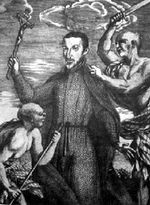
The first European to travel to Guam was Portuguese navigator Ferdinand Magellan, sailing for the King of Spain, when he sighted the island on March 6, 1521, during his fleet's circumnavigation of the globe.[16] Despite Magellan's visit, Guam was not officially claimed by Spain until January 26, 1565, by Miguel López de Legazpi.[16] From 1565 to 1815, Guam and the Northern Mariana Islands, the only Spanish outposts in the Pacific Ocean east of the Philippines, were reprovisioning stops for the Manila galleons, a fleet that covered the Pacific trade route between Acapulco and Manila.[16]
Spanish colonization commenced on June 15, 1668, with the arrival of a mission led by Diego Luis de San Vitores, who established the first Catholic church.[16] The islands were part of the Spanish East Indies, and in turn part of the Viceroyalty of New Spain, based in Mexico City.[16] The Spanish-Chamorro Wars on Guam began in 1670 over growing tensions with the Jesuit mission, with the last large-scale uprising in 1683. Intermittent warfare, plus the typhoons of 1671 and 1693, and in particular the smallpox epidemic of 1688, reduced the Chamoru population from 50,000 to 10,000, finally to less than 5,000.[16]
The island became a rest stop for whalers starting in 1823.[16] A devastating typhoon struck the island on August 10, 1848, followed by a severe earthquake on January 25, 1849, which resulted in many refugees from the Caroline Islands, victims of the resultant tsunami.[16] After a smallpox epidemic killed 3,644 Guamanians in 1856, Carolinians and Japanese were permitted to settle in the Marianas.[16]
العصر الأمريكي
After almost four centuries as part of the Kingdom of Spain, the United States occupied the island following Spain's defeat in 1898 Spanish–American War, as part of the Treaty of Paris of 1898. Guam was transferred to the United States Navy control on December 23, 1898, by Executive Order 108-A from 25th President William McKinley.
هاگاتنيا عاصمة گوام تقع في خليج أگانيا على الساحل الغربي للجزيرة، تنمو نباتات استوائية كثيفة بالقرب من أغانيا وتغطي معظم بقية أنحاء گوام.
الحرب الاسبانية الأمريكية والحرب العالمية الثانية
قاد المستكشف البرتغالي فرديناند ماجلان أول بعثة أوروبية لگوام، ووصل فريقه هناك في عام 1521م. وجعلت إسبانيا من گوام ملكية إسبانية عام 1561، وتنازلت عنها للولايات المتحدة عقب انتهاء الحرب الإسبانية الأمريكية في عام 1898، ومن ثم وُضِعَتْ تحت إدارة البحرية الإمريكية. وهاجمت اليابان گوام في 8 ديسمبر 1941 واحتلتها في العاشر من الشهر نفسه. ونزلت القوات الأمريكية في گوام في 21 يوليو 1944م ولكنها لم تسترجع الجزيرة تمامًا حتى العاشر من أغسطس 1944.
وفي عام 1954، أنشأت القيادة الجوية الإستراتيجية لسلاح الجو الأمريكي قاعدة أندرسن الجوية، واتخذت من گوام مقرًا لقيادتها في منطقة المحيط الهادئ. وفي عام 1962، دّمر إعصارٌ حوالي 90% من مباني گوام وقتل 9 أشخاص. ولكن تم تشييد العديد من المباني الجديدة منذ ذلك الوقت.
وأعلنت الولايات المتحدة أن گوام جزء من أراضيها في الأول من أغسطس 1950، ونقلت الإشراف عليها من البحرية إلى وزارة الداخلية، وأصبح سكانها مواطنين أمريكيين. وينتخب الناخبون في گوام هيئة تشريعية من مجلس واحد، وينتخبون حاكمًا ونائبًا له، مرة كل أربع سنوات. وقبل عام 1970 كان الرئيس الأمريكي هو الذي يتولى تعيين حكام گوام. ولكن منذ عام 1972، بدأ سكان گوام في انتخاب وفد لمجلس النواب الأمريكي. ويحق للنواب التصويت في اللجان التابعة لمجلس النواب ولكن ليس في المجلس ذاته.
. . . . . . . . . . . . . . . . . . . . . . . . . . . . . . . . . . . . . . . . . . . . . . . . . . . . . . . . . . . . . . . . . . . . . . . . . . . . . . . . . . . . . . . . . . . . . . . . . . . . . . . . . . . . . . . . . . . . . . . . . . . . . . . . . . . . . . . . . . . . . . . . . . . . . . . . . . . . . . . . . . . . . . . .
الجغرافيا
توجد حواجز مرجانية قبالة ساحل گوام، وترتفع هضبة جيرية على الجزء الشمالي من الجزيرة. وتمت إزالة العديد من الغابات في الشمال لإنشاء المزارع والمطارات. وفي النصف الجنوبي من الجزيرة سلسلة جبلية بركانية الأصل. وتنبع العديد من الأنهار في الجبال وتصب في الساحل. وتضرب الزلازل الجزيرة بين حين وآخر. ويوجد متنزه الحرب في الباسفيكي التاريخي الوطني - الذي أقيم تخليدًا لذكرى الجنود الأمريكيين الذين قاتلوا في المحيط الهادئ خلال الحرب العالمية الثانية (1939- 1945م)- في گوام.
وطقس گوام دافئ معظم السنة، ويتراوح متوسط درجات الحرارة بين 20 و 32°م، بيد أن الأعاصير كثيرًا ما تجتاح الجزيرة. ويبلغ متوسط هطول الأمطار 230 سم في العام. ويستمر موسم هطول الأمطار من مايو إلى نوفمبر.
الطقس
| بيانات مناخ Guam International Airport (1991–2020 normals, extremes 1945–present) | |||||||||||||
|---|---|---|---|---|---|---|---|---|---|---|---|---|---|
| الشهر | يناير | فبراير | مارس | أبريل | مايو | يونيو | يوليو | أغسطس | سبتمبر | اكتوبر | نوفمبر | ديسمبر | العام |
| العظمى القياسية °ف (°س) | 94 (34.4) |
93 (33.9) |
93 (33.9) |
96 (35.6) |
94 (34.4) |
95 (35) |
95 (35) |
94 (34.4) |
94 (34.4) |
93 (33.9) |
92 (33.3) |
91 (32.8) |
96 (35٫6) |
| العظمى المتوسطة °ف (°س) | 85.7 (29.83) |
85.7 (29.83) |
86.7 (30.39) |
87.9 (31.06) |
88.5 (31.39) |
88.5 (31.39) |
87.7 (30.94) |
87.0 (30.56) |
87.0 (30.56) |
87.2 (30.67) |
87.4 (30.78) |
86.6 (30.33) |
87٫2 (30٫67) |
| المتوسط اليومي °ف (°س) | 80.3 (26.83) |
80.1 (26.72) |
81.0 (27.22) |
82.3 (27.94) |
83.0 (28.33) |
83.1 (28.39) |
82.2 (27.89) |
81.5 (27.5) |
81.5 (27.5) |
81.7 (27.61) |
82.2 (27.89) |
81.6 (27.56) |
81٫7 (27٫61) |
| الصغرى المتوسطة °ف (°س) | 75.0 (23.89) |
74.6 (23.67) |
75.4 (24.11) |
76.7 (24.83) |
77.5 (25.28) |
77.7 (25.39) |
76.8 (24.89) |
76.1 (24.5) |
76.0 (24.44) |
76.3 (24.61) |
77.0 (25) |
76.5 (24.72) |
76٫3 (24٫61) |
| الصغرى القياسية °ف (°س) | 66 (18.9) |
65 (18.3) |
66 (18.9) |
68 (20) |
70 (21.1) |
70 (21.1) |
70 (21.1) |
70 (21.1) |
70 (21.1) |
67 (19.4) |
68 (20) |
68 (20) |
65 (18٫3) |
| هطول inches (mm) | 5.34 (135.6) |
4.15 (105.4) |
2.77 (70.4) |
3.50 (88.9) |
4.45 (113) |
6.51 (165.4) |
12.25 (311.2) |
17.66 (448.6) |
15.17 (385.3) |
12.73 (323.3) |
8.29 (210.6) |
5.30 (134.6) |
98٫12 (2٬492٫2) |
| % Humidity | 83.7 | 81.9 | 83.1 | 82.0 | 82.7 | 82.7 | 87.3 | 88.7 | 88.8 | 88.3 | 86.6 | 83.0 | 84٫9 |
| Avg. precipitation days (≥ 0.01 in) | 20.1 | 18.0 | 18.3 | 18.9 | 19.7 | 23.2 | 26.0 | 25.9 | 25.1 | 25.4 | 23.9 | 22.7 | 267٫2 |
| Sunshine hours | 176.0 | 173.7 | 216.4 | 214.0 | 219.9 | 193.8 | 156.1 | 142.2 | 132.7 | 132.6 | 135.0 | 143.4 | 2٬035٫8 |
| Source: NOAA (relative humidity and sun 1961–1990)[17][18][19] | |||||||||||||
البيئة
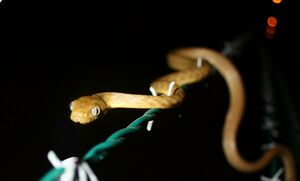
Guam has experienced severe impacts from invasive species upon the natural biodiversity of the island. These include the local extinction of endemic bird species after the introduction of the brown tree snake, an infestation of the Asiatic rhinoceros beetle destroying coconut palms, and the effect of introduced feral mammals and amphibians.
. . . . . . . . . . . . . . . . . . . . . . . . . . . . . . . . . . . . . . . . . . . . . . . . . . . . . . . . . . . . . . . . . . . . . . . . . . . . . . . . . . . . . . . . . . . . . . . . . . . . . . . . . . . . . . . . . . . . . . . . . . . . . . . . . . . . . . . . . . . . . . . . . . . . . . . . . . . . . . . . . . . . . . . .
الديمغرافيا
| التعداد التاريخي | |||
|---|---|---|---|
| التعداد | Pop. | %± | |
| 1910 | 11٬806 | — | |
| 1920 | 13٬275 | 12٫4% | |
| 1930 | 18٬509 | 39٫4% | |
| 1940 | 22٬290 | 20٫4% | |
| 1950 | 59٬498 | 166٫9% | |
| 1960 | 67٬044 | 12٫7% | |
| 1970 | 84٬996 | 26٫8% | |
| 1980 | 105٬979 | 24٫7% | |
| 1990 | 133٬152 | 25٫6% | |
| 2000 | 154٬805 | 16٫3% | |
| 2010 | 159٬358 | 2٫9% | |
| 2020 | 153٬835 | −3٫5% | |
According to the 2010 United States Census, the largest ethnic group are the native Chamorus, accounting for 37.3% of the total population. Asians (including Filipinos, Koreans, Chinese, and Japanese) account for 33% of the total population. Other ethnic groups of Micronesia (including those of Chuukese, Palauan, and Pohnpeians) accounts for 10% of the total population. 9.4% of the population are multiracial (two or more races). White Americans account for 7.1% of the total population. The estimated interracial marriage rate is over 40%.[1]
The official languages of the island are English and Chamoru. Filipino is also a common language across the island. Other Pacific island languages and many Asian languages are spoken in Guam as well. Spanish, the language of administration for 300 years, is no longer commonly spoken on the island, although vestiges of the language remain in proper names, loanwords, and place names and it is studied at university and high schools.[بحاجة لمصدر]
الدين الأكثر شيوعاً هو الكاثوليكية. وحسب مركز پيو للأبحاث، فإن الطوائف الدينية تتألف من التالين، في 2010:[20]
- الكاثوليكية الرومانية: 75%
- الپروتستانتية: 17.7%
- أديان أخرى: 1.6%
- أديان شعبية: 1.5%
- مسيحية أخرى: 1.4%
- البوذية: 1.1%
- الأرثوذكسية الشرقية: <1%
- الهندوسية: <1%
- الإسلام: <1%
- اليهودية: <1%
الثقافة
The culture of Guam is a reflection of traditional Chamoru customs in combination with American, Spanish and Mexican traditions.[21] Post-European-contact Chamoru Guamanian culture is a combination of American, Spanish, Filipino, other Micronesian Islander and Mexican traditions. Few indigenous pre-Hispanic customs remained following Spanish contact. Hispanic influences are manifested in the local language, music, dance, sea navigation, cuisine, fishing, games (such as batu, chonka, estuleks, and bayogu), songs, and fashion.[بحاجة لمصدر] The island's original community is of Chamorro natives who have inhabited Guam for almost 4000 years.[22] They had their own language related to the languages of Indonesia and southeast Asia. The Spanish later called them Chamorros, a derivative of the word Chamorri is "noble race"). They began to grow rice on the island.[23]
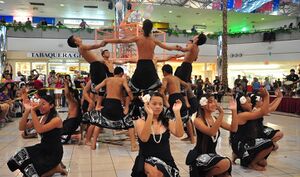
الأقسام الإدارية
گوام مقسمة إلى 19 قرية هم: أسان، أغات، أگانيا، إناراجان، أوماتاك، باريغادا، بيتي، تالافوفو، تامونينگ، تشالان باگو أوردوت، ديديدو، سانتا ريتا، سيناجانا، مانگيلاو، مرتفعات أگانيا، مونومونگ توتو مايت، ميريزو، يغو، يونا.
السكان
معظم الگواميين من الشامورو، سكان الجزر الذين ينتمون أساسًا لأصول ميكرونيزية وفلبينية وأسبانية. وينحدر آخرون من مستوطنين أمريكيين وإيطاليين وفرنسيين وبريطانيين ويابانيين. وسُدسُ سكان گوام جنود عسكريون أمريكيون مع عوائلهم. واللغة الرسمية لگوام هي الإنجليزية، ولكن معظم الناس يتحدثون لغة الشامورو. والرومانية الكاثوليكية هي الديانة التي يعتنقها معظم السكان و يوجد أقلية اسلامية بالجزيرة تمثلها رابطة المسلمين في گوام. وجامعة گوام في مانجيلاو هي الجامعة الوحيدة في الجزيرة؛ وأكبر مدنها تامونينج.
الثقافة

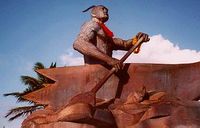
الاقتصاد
يرتكز اقتصاد گوام أساسًا على الجيش الأمريكي والسياحة. ويحتفظ الجيش الأمريكي بقاعدة أجانا البحرية والعديد من المنشآت البحرية الأخرى على الجزيرة. وتوفر المنشآت العسكرية العديد من الوظائف للگواميين. ويزور آلاف السياح، ومعظمهم من اليابانيين، گوام كل عام. والزراعة وصيد السمك نشاطان اقتصأديان صغيران. ويزرع الفلاحون جوز الهند والبطاطا الحلوة والقلقاس (خضار جذري). والتونة أهم أسماك الجزيرة. وميناء گوام الرئيسي هو آبرا.
الحكومة والسياسة
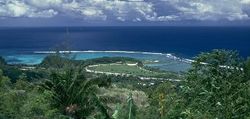
گوام مقسمة إلى 19 قرية هم: أسان، أغات، أغانيا، إناراجان، أوماتاك، باريغادا، بيتي، تالافوفو، تامونينغ، تشالان باغو أوردوت، ديديدو، سانتا ريتا، سيناجانا، مانغيلاو، مرتفعات أغانيا، مونومونغ توتو مايت، ميريزو، يغو، يونا.
القرى والقواعد العسكرية
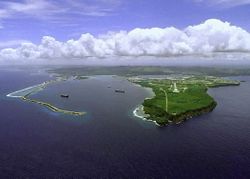
موضوعات بيئية
Guam exemplifies the effects of bioinvasion.
ثعبان الأشجار البني
Other invasive animal species

الحياة البرية
انظر أيضا
المصادر
- ^ أ ب ت ث ج "Australia-Oceania :: Guam (Territory of the US)". The World Factbook. Central Intelligence Agency. Archived from the original on ديسمبر 3, 2013. Retrieved أغسطس 26, 2015.
{{cite web}}: Unknown parameter|deadurl=ignored (|url-status=suggested) (help) - ^ "Guam | Data". data.worldbank.org. Retrieved 2021-08-09.
- ^ "Guam". Archived from the original on September 12, 2017. Retrieved September 12, 2017.
- ^ "U.S. Territories". DOI Office of Insular Affairs. Archived from the original on February 9, 2007. Retrieved February 9, 2007.
- ^ "Definitions of Insular Area Political Organizations". U.S. Department of the Interior. Archived from the original on July 21, 2011. Retrieved November 14, 2007. Office of Insular Affairs. Retrieved October 31, 2008.
- ^ War Restitution Act : hearing before the Subcommittee on Insular and International Affairs of the Co...|National Library of Australia Archived أبريل 6, 2010 at the Wayback Machine. Catalogue.nla.gov.au (September 20, 1994). Retrieved June 13, 2012.
- ^ "Statement of David B. Cohen Deputy Assistant Secretary of the Interior for Insular Affairs Before the House Committee on Resources Regarding the Report of the Guam War Claims Review Commission|July 21, 2004 Archived يناير 20, 2013 at the Wayback Machine." Office of Insular Affairs. Retrieved September 19, 2012.
- ^ Higuchi, Wakako (2001). "The Japanisation Policy for the Chamorros of Guam, 1941–1944" (PDF). The Journal of Pacific History. 36 (1): 19–35. doi:10.1080/00223340120049424. Archived from the original (PDF) on January 20, 2013.
- ^ "Guam police arrest suspect in memorial theft". Marine Corps Times. Associated Press. July 7, 2007. Archived from the original on May 15, 2011. Retrieved April 5, 2010.
- ^ Rogers, Robert F. (1995). Destiny's Landfall: A History of Guam. Honolulu: University of Hawaii Press. ISBN 978-0-8248-1678-0.
- ^ Mack, Doug (2017). The Not-Quite States of America: Dispatches From the Territories and Other Far-Flung Outposts of the USA. W.W. Norton. p. 114. ISBN 9780393247602.
- ^ Grabowski, John F. (1992). U.S. Territories and Possessions (State Report Series). Chelsea House. p. 39. ISBN 9780791010532.
- ^ "Non-Self-Governing Territories – Official U.N. Website". Archived from the original on February 27, 2014. Retrieved November 18, 2019.
- ^ Hung, Hsiao-chun; Carson, Mike T.; Bellwood, Peter; Campos, Fredeliza Z.; Piper, Philip J.; Dizon, Eusebio; Bolunia, Mary Jane Louise A.; Oxenham, Marc; Chi, Zhang (2015). "The first settlement of Remote Oceania: the Philippines to the Marianas". Antiquity. 85 (329): 909–926. doi:10.1017/S0003598X00068393.
- ^ Zotomayor, Alexie Villegas (March 12, 2013). "Archaeologists say migration to Marianas longest ocean-crossing in human history". Marianas Variety News and Views: 2. Retrieved October 25, 2020.
- ^ أ ب ت ث ج ح خ د ذ ر ز س ش ص ض Carano, Paul; Sanchez, Pedro C. (1964). A Complete History of Guam. Tokyo: Charles E. Tuttle Company. OCLC 414965.
- ^ "NowData - NOAA Online Weather Data". National Oceanic and Atmospheric Administration. Retrieved September 11, 2021.
- ^ "Station: Guam INTL AP, GU GQ". U.S. Climate Normals 2020: U.S. Monthly Climate Normals (1991-2020). National Oceanic and Atmospheric Administration. Retrieved September 11, 2021.
- ^ "WMO Climate Normals for Guam/Marshall Islands, PI 1961–1990". National Oceanic and Atmospheric Administration. Archived from the original on September 11, 2021. Retrieved September 11, 2021.
- ^ "Guam - Religious Demography: Affiliation". Pew-Templeton Global Religious Futures Project. Retrieved 25 March 2021.
- ^ Wuerch & Ballendorf 1994, p. 44.
- ^ Cunningham & Beaty 2001, p. 5-6.
- ^ Cunningham & Beaty 2001, p. 5.
وصلات خارجية
- الحكومة
- Official Portal for the Island of Guam
- Office of the Governor
- Congresswoman Madeleine Z. Bordallo, Delegate, U.S. Congress
- Guam Customs and Quarantine Agency
- Guam Election Commission
- Guam Code Annotated
- Guam Department of Revenue and Taxation
- Guam's Original Webpage
- معلومات عامة
- allthingsguam A Guam History resource--virtual textbook, virtual workbook and more
- Guampedia, Guam's Online Encyclopedia from the Guam Humanities Council and the University of Guam
- Guam entry at The World Factbook
- جوام at the Open Directory Project
- Portals to the World: Guam from the U.S. Library of Congress
 Wikimedia Atlas of Guam
Wikimedia Atlas of Guam- Guam Connection - Guam directory and internet portal.
- إعلام
- عسكرية وتاريخ
- Commander, Naval Forces Marianas (COMNAVMAR) Guam
- Andersen Air Force Base (AAFB) Guam
- War in the Pacific - Liberation of Guam
- Congressional Testimony - Guam War Claims
- Government of Guam's website for the upcoming military buildup
- سفر
- فصائل غازية
- (Potentially) Invasive plant species on Guam (info from the Pacific Island Ecosystems at Risk project (PIER))
- Brown tree snake (Boiga irregularis) information from the [http://www.hear.org/ Hawaiian Ecosystems at Risk project (HEAR)
- أخرى
- Guam Chamber of Commerce
- Maps - Perry-Castañeda Library Map Collection
- National Weather Service - Guam
- Guam.com - Guam
- CS1 errors: unsupported parameter
- Short description is different from Wikidata
- Coordinates on Wikidata
- Articles containing تشامورو-language text
- Lang and lang-xx code promoted to ISO 639-1
- Pages using infobox country with unknown parameters
- Articles with hatnote templates targeting a nonexistent page
- مقالات ذات عبارات بحاجة لمصادر
- Articles with unsourced statements from March 2021
- دول اوقيانوسية
- گوام
- تأسيسات 1898 في أوقيانوسيا
- مستعمرات اسبانية سابقة
- المناطق الجزرية في الولايات المتحدة
- مناطق وبلدان تتحدث الانجليزية
- مايكرونيزيا
- جزر أوقيانوسيا
- بلدان اوقيانوسيا
- جغرافيا ميكرونيزيا
- بلدان جزر
- أعضاء منظمة الأمم والشعوب غير الممثلة
- Pacific islands of the United States
- Small Island Developing States
- دول وأقاليم تأسست في 1898
- مواقع الحرب العالمية الثانية





